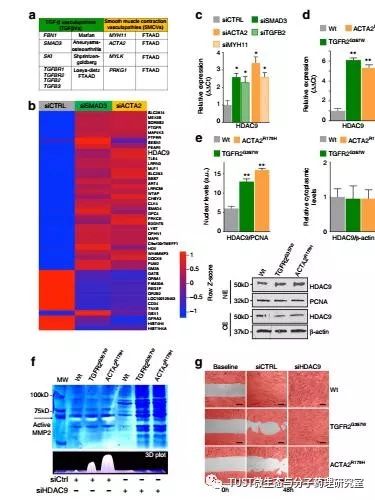BACKGROUND INTRODUCTION Under the influence of different external factors, vascular smooth muscle cells (VSMCs) have different cell phenotypes and have strong plasticity. The VSMCs in the normal vascular membrane are highly differentiated cells, which mainly maintain the vascular morphology and contract blood vessels, and have the characteristics of low proliferation, low migration and low protein secretion. When vascular lesions, VSMCs can be dedifferentiated into undifferentiated. The cells have decreased cell contractility and exhibit high proliferation, high migration, and high protein secretion. Studies have found that human sequence variants of the histone deacetylase 9, HDAC9 locus are associated with vascular diseases such as macrovascular ischemic stroke, myocardial infarction, intracranial aneurysms, and aortic calcification. It shows that HDAC9 has a close relationship with cardiovascular disease. 2018, Harvard Medical School Christian L. Lino Cardenas et al. published an article entitled "An HDAC9-MALAT1-BRG1 complex mediates smooth muscle dysfunction in thoracic aortic Aneurysm" in Nature Communications magazine (IF2017=12.353, Comprehensive Journal Zone 1). Main method used METHODS 1. RNA knockdown assay 2. Scratch test 3. Microarray 4. Western blot 5. RT-PCR 6. Immunoprecipitation (Co-IP): A classical method for studying protein-protein interactions based on the specificity between antibodies and antigens. It is an effective method for determining the physiological interaction of two proteins in intact cells. 7. Zymography: Based on SDS-PAGE electrophoresis and reversed-phase gel staining, this method is used to detect MMP-2 and MMP-9 activities. 8. Fluorescence in situ hybridization (FISH): if the target DNA on the chromosome or DNA fiber slice to be detected is homologously complementary to the nucleic acid probe used, both undergo denaturation-annealing-refolding, ie A hybrid of the target DNA and the nucleic acid probe can be formed. 9. Chromatin immunoprecipitation (ChIP): Chromatin is cut into small fragments and precipitated by using a bio-antibody corresponding to a specific histone label while maintaining histone and DNA combination. 10. CLIP-seq (crosslinking-immunprecipitation and high-throughput sequencing): UV-crosslinking immunoprecipitation combined with high-throughput sequencing allows high-throughput studies of the binding mode of RNA-binding proteins to numerous RNA targets in vivo and reveals their importance in some important organisms. The function of the process is a new technology that reveals the interaction between RNA molecules and RNA-binding proteins at the genome-wide level. ABSTRACT Thoracic aortic aneurysm (TAA) is associated with mutations affecting members of the TGF-β signaling pathway, or mutations affecting vascular smooth muscle cell (VSMC) actin cytoskeletal components and regulatory factors. Although these two different mutations show similar phenotypes in the clinic, the underlying pathogenesis is still unclear. This study found that mutations affecting TGF-β signaling and VSMC cytoskeletal lead to the formation of ternary complexes including histone deacetylase HDAC9, chromatin remodeling enzyme BRG1 and long non-coding RNA MALAT1 . This HDAC9-MALAT1-BRG1 complex binds to chromatin and inhibits contractile protein gene expression, while causing an increase in histone H3-lysine 27 trimethylation. Destruction of Malat1 or Hdac9 restores contractile protein expression, improves aortic wall structure, and inhibits the growth of experimental aneurysms. Therefore, this study demonstrates that vascular smooth muscle cell (VSMC) dysfunction has a common epigenetic pathway in two different forms of thoracic aortic aneurysm (TAA), which is also potential for other known HDAC9-associated vascular diseases. The meaning of treatment. Headband Mask,Dust Mask Protective,N95 Certification Mask,Coronavirus Design Disposable Face Mask KUTA TECHNOLOGY INDUSTRY CO.,LIMITED , https://www.kutasureblue.com